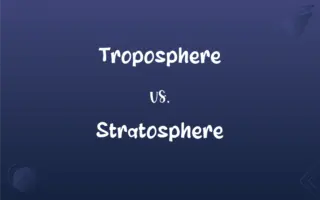Plants vs. Humans: What's the Difference?
Edited by Aimie Carlson || By Harlon Moss || Published on February 6, 2024
Plants are living organisms that primarily perform photosynthesis, lack mobility and complex nervous systems, whereas humans are highly developed mammals with advanced cognitive abilities, mobility, and complex social structures.

Key Differences
Plants primarily perform photosynthesis, converting light energy into chemical energy, and don't have a central nervous system. Humans, on the other hand, rely on a complex nervous system for sensory perception and a diverse diet for energy.
Plants have a fixed structure with roots, stems, and leaves, and lack a skeletal system. Humans possess a skeletal structure, enabling mobility and a wide range of physical activities.
Plants reproduce through various methods, including seeds and spores, and exhibit continuous growth. Human reproduction is sexual, involving complex societal and emotional aspects, and growth is finite.
Plants respond to their environment through slow processes like phototropism, but lack conscious thought. Humans have a rapid and conscious response to their environment, facilitated by advanced cognitive abilities.
Plants are primary producers in ecosystems, creating organic material from inorganic substances. Humans, as consumers, rely on other organisms, including plants, for sustenance and have a significant impact on ecosystems.
ADVERTISEMENT
Comparison Chart
Energy Acquisition
Photosynthesis, creating their own food
Consuming organic substances for energy
Structure
Fixed, with roots, stems, and leaves
Mobile, with a skeletal system
Reproduction
Seeds, spores, vegetative propagation
Sexual reproduction with complex sociality
Sensory Response
Slow, non-conscious responses
Rapid, conscious sensory responses
Ecosystem Role
Primary producers
Consumers, significantly altering ecosystems
ADVERTISEMENT
Plants and Humans Definitions
Plants
Living organisms that produce their own food through photosynthesis.
The garden was full of vibrant plants converting sunlight into energy.
Humans
Organisms that adapt and manipulate their environment for survival.
Humans built cities and technologies to adapt to various environmental challenges.
Plants
Organisms capable of reproducing through seeds, spores, or vegetative means.
New plants sprouted in the spring, growing from scattered seeds.
Humans
Highly developed mammals with advanced cognitive abilities.
Humans have transformed the planet with their unique intelligence and creativity.
Plants
Beings that adapt to their environment through growth and slow responses.
The plants in the desert had adapted to conserve water in harsh conditions.
Humans
Beings characterized by bipedalism, complex language, and social structures.
Throughout history, humans have formed societies with intricate cultures and languages.
Plants
Entities in ecosystems that are primary producers, crucial for life on Earth.
The rainforest's plants play a vital role in supporting diverse wildlife.
Humans
Species known for their emotional depth and artistic expressions.
Humans express a wide range of emotions through art, music, and literature.
Plants
Organisms characterized by a fixed structure, including roots, stems, and leaves.
Plants in the forest competed for sunlight with their tall stems and broad leaves.
Humans
A species with a significant impact on Earth's ecosystems and climate.
The actions of humans have had profound effects on the global climate and biodiversity.
Plants
Any of various photosynthetic, eukaryotic, multicellular organisms of the kingdom Plantae characteristically containing chloroplasts, having cell walls made of cellulose, producing embryos, and lacking the power of locomotion. Plants include trees, bushes, herbs, ferns, mosses, and certain green algae.
Humans
A member of the primate genus Homo, especially a member of the species Homo sapiens, distinguished from other apes by a large brain and the capacity for speech.
FAQs
Do humans have a direct role in plant life?
Yes, humans impact plant life through activities like agriculture, deforestation, and gardening.
How do plants reproduce?
Plants reproduce through seeds, spores, and sometimes vegetative parts.
How do humans reproduce?
Human reproduction is sexual, involving complex emotional and societal aspects.
What allows humans to be mobile?
The human skeletal and muscular systems enable mobility.
Can plants feel pain?
Plants lack a nervous system, so they do not feel pain like humans.
What is a plant?
A living organism that typically conducts photosynthesis and has a fixed structure.
Are plants mobile?
Plants are generally immobile and grow in fixed places.
How do plants contribute to the ecosystem?
Plants are primary producers, creating organic matter from sunlight and inorganic substances.
Can plants adapt to their environment?
Plants adapt over time to their environment through growth and slow physiological changes.
What defines a human?
A highly developed mammal known for its cognitive abilities and complex social structures.
How do plants get their energy?
Plants produce energy through photosynthesis, using sunlight.
What is the role of water in plant life?
Water is essential for plant growth, photosynthesis, and nutrient transport.
Do plants have a lifespan?
Yes, plants have varying lifespans, from a few weeks to hundreds of years.
How do humans get energy?
Humans consume organic substances like plants and animals for energy.
What is the role of water in human life?
Water is vital for human survival, aiding in digestion, temperature regulation, and nutrient transport.
Can plants communicate?
Plants communicate indirectly through chemical signals, not like human language.
How do humans affect ecosystems?
Humans can significantly alter ecosystems through activities like urbanization and pollution.
How do humans communicate?
Humans use complex languages, both verbal and written, for communication.
What is the human lifespan?
The human lifespan varies but typically ranges from 70 to 100 years.
Can humans adapt to different environments?
Humans adapt to various environments through technology, culture, and physiological acclimatization.
About Author
Written by
Harlon MossHarlon is a seasoned quality moderator and accomplished content writer for Difference Wiki. An alumnus of the prestigious University of California, he earned his degree in Computer Science. Leveraging his academic background, Harlon brings a meticulous and informed perspective to his work, ensuring content accuracy and excellence.
Edited by
Aimie CarlsonAimie Carlson, holding a master's degree in English literature, is a fervent English language enthusiast. She lends her writing talents to Difference Wiki, a prominent website that specializes in comparisons, offering readers insightful analyses that both captivate and inform.






































































